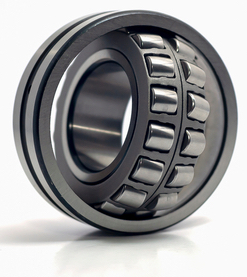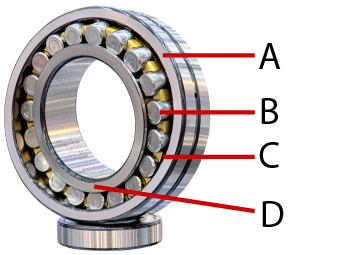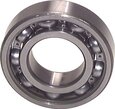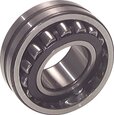Spherical Roller Bearings

Figure 1: Spherical roller bearing
Spherical roller bearings are rolling bearings with one or two rows of barrel-shaped rollers positioned at an angle to the bearing axis. This bearing type is among the most popular due to their ability to self-align. These bearings are more robust and can handle higher loads, both radial and axial, and more evenly spread out the load on the rollers. Heavy-duty applications, such as mining, construction equipment, and industrial machinery, commonly use these bearings. This article further discusses the construction of spherical roller bearings, how they operate, their advantages and disadvantages, and compares them to other common bearing types.
Table of contents
- Applications
- Spherical roller bearing design
- Spherical roller bearings aspects
- Spherical roller bearings vs other bearing types
- FAQs
View our online selection of bearings!
Applications
Spherical roller bearings are suitable for heavy industry applications due to their ability to handle misalignment and shaft displacement. For example:
- Conveyor systems: Spherical roller bearings support the shafts that drive the belts. Misalignment and shaft deflection occur due to uneven loading, belt tension, or temperature changes.
- Wind turbines: Spherical roller bearings support the rotor shaft and the gearbox. Misalignment and shaft deflection can happen by wind direction changes, wind speed variations, or the turbine blades' weight.
- Paper machines: Spherical roller bearings support the rollers that move and shape the paper web. Tension variations and roller speed can cause misalignment and shaft deflection.
- Construction equipment: Spherical roller bearings support rotating components, such as a crane's hook or slew ring. Misalignment and shaft deflection can be caused by uneven loading or movement on uneven surfaces.
- Mining equipment: Spherical roller bearings support mining equipment components such as conveyor pulleys or crusher shafts. Large forces generated during the extraction process can cause misalignment or shaft deflection.
Inappropriate applications
Despite their versatility, spherical roller bearings are not suitable for every application. For example:
- Precision machinery: The spherical shape of the rollers allows for some degree of play or looseness in the bearing, which affects the precision. Bearings more suitable for high precision are angular contact ball bearings, cylindrical roller bearings, tapered roller bearings, or precision deep groove ball bearings.
- Low-load applications: Spherical bearings are best suited for heavy loads. Deep groove ball bearings and cylindrical roller bearings are more appropriate for lower loads.
- Extreme temperature environments: Spherical roller bearings are not the best choice for industrial applications with high heat. Specialized bearings with high-temperature materials may be necessary.
Spherical roller bearing design
As seen in Figure 2, a spherical roller bearing has the following components:
- Outer ring (A): The contact surface of the outer ring has a spherical surface. This allows the rollers to move sideways.
- Rollers (B): The barrel-shaped rollers have a spherical contact surface with a curvature that allows for the bearing to handle axial loads. Spherical roller bearings with two rows of rollers, also known as axial spherical roller bearings, are ideal for higher axial loads. Spherical roller bearings with one row of rollers are suitable for applications that encounter minimal axial loads. The rollers in each row are angled in opposing directions to resist thrust loads in either direction.
- Cage (C): A cage holds the rollers in place.
- Inner ring (D): The inner ring's contact surface has two raceways for the rollers to move along.
Although the axial handling capacity of spherical roller bearings is less than that of an angular contact bearing, spherical bearings can handle these axial loads in both directions. Angular contact bearings can do this only in one direction unless mounted in a back-to-back or face-to-face configuration.

Figure 2: A spherical roller bearing's primary components: outer ring (A), roller (B), cage (C), and inner ring (D).
Tapered vs cylindrical bore
Spherical roller bearings can have a tapered or cylindrical bore. Choosing between the two is based on the following:
- Rotational speed: For applications with high rotational speeds, bearings with tapered bores are preferred.
- Misalignment: Bearings with tapered bores can handle more misalignment than cylindrical bores.
- Load: A spherical roller bearing with a tapered bore can handle heavier loads than those with cylindrical bores.
- Shaft design: Like bearings, shafts can have cylindrical or tapered outer diameters.
- Vibrations: Applications with heavy vibrations should have spherical roller bearings with tapered bores.
The primary reason why spherical roller bearings with tapered bores operate better on the above factors is due to the ability of adjusting their internal clearances. Internal clearance is the distance between the rollers and the raceways. If the clearance is too small, there can be extreme wear and tear; if the clearance is too large, there will be excessive vibrations, leading to reduced load capacity and life. Adjustment is accomplished using a tapered adapter sleeve (see below).
Spherical roller bearings aspects
This section discusses four important aspects of spherical roller bearings:
- Misalignment
- Materials
- Lubrication
- Mounting options
Spherical roller bearings misalignment
There are various reasons why bearing misalignment occurs. However, for spherical roller bearings, the primary reason for misalignment is related to them being used in heavy industrial applications. Spherical roller bearings support and guide rotating shafts, which can deflect under heavy loads, leading to bearing misalignment. Also, heavy vibrations can cause misalignment.
Spherical roller bearings can handle axle misalignment up to 2°. For applications with more than 2° deflection, self-aligning bearings may be a suitable solution.
Spherical roller bearings material
The outer and inner rings and rollers in a spherical roller bearings are most often made of chrome steel, which is the common material for many different types of bearings. This material has been standardized to some degree:
- AISI 52100 (United States)
- DIN 17230
- 100CR6 (Germany)
- SUJ2 (Japan)
- GCR15 (China)
The common cage materials are:
- Steel
- Brass
- Polyamide
- Sheet steel
Spherical roller bearing lubrication
As with all bearings, spherical roller bearings must be adequately lubricated with grease or oil. Grease has a lower operational speed capacity than oil. For high-speed applications, oil is a better choice.
If grease is preferred, choose a bearing well suited for this lubrication type. Often, manufacturers build a grease groove into the outer raceway to make for easy application of grease using grease nipples.
If oil is the preferred choice, this can be done through a sealed bearing with an oil reservoir or oil-bath lubrication. With an oil bath, only the lowest roller should contact the oil. This allows for splash lubrication. If more than the lowest roller contacts the oil, the bearing will need more force to bring the rollers through it, losing its effectiveness and speed advantage.
Figure 3: Bearing lubrication
Spherical roller bearing mounting methods
There are three main ways in which spherical rolling bearings are typically mounted:
- Set screw
- Tapered adapter
- Direct shaft
Set screw mounted
The bearing is mounted with a collar and set screws, bolts entirely threaded across their length. As a rule, set screw-mounted bearings are designed to support light to moderate loads, but not heavy loads. The expected loads determine screw sizes if the screws are tightened to their total capacity. Choosing a screw size that is too big results in excessive ring bending. Following the manufacturers' recommendations regarding shaft fit and set screw tightening is crucial to achieving the desired bearing performance, especially when operating under heavier loads or higher speeds.
Tapered adapter sleeve
Tapered adapter sleeves can mount a spherical roller bearing with a tapered bore to a shaft with a cylindrical or slightly tapered outside diameter. The sleeve fits over the shaft and has a tapered inside that matches the bearing's taper.
A tapered adapter sleeve is generally made of steel. It is split along its length, allowing easy installation and removal. The primary reason tapered adapter sleeves are preferred is their simple installation. They do not require additional machining or special tools. The sleeve is tightened on the shaft using a nut or locking device. This compresses the sleeve onto the shaft, creating a secure and stable fit.
Direct shaft mounted spherical roller bearings
Direct shaft-mounted spherical roller bearings have a cylindrical bore and mount directly to relatively small cylindrical shafts. Direct mounting eliminates the need for additional components and simplifies the assembly process. This mounting style is suitable for applications with limited space for mounting components.
Spherical roller bearings vs other bearing types
Cylindrical roller bearings vs spherical roller bearings
The primary differences between spherical and cylindrical roller bearings are the loads they accommodate and their ability to handle misalignment. They also differ in friction coefficient and application.
- Loads: Cylindrical roller bearings handle high radial loads and small axial loads. Spherical roller bearings, though, not only handle radial loads but also handle higher axial loads.
- Misalignment: Cylindrical roller bearings do not handle misalignment, unlike spherical roller bearings.
- Friction: Cylindrical roller bearings have a lower friction coefficient than spherical roller bearings and, therefore, can handle higher-speed applications.
- Applications: Cylindrical roller bearings are found in machineries such as pumps, compressors, and gearboxes. Spherical roller bearings can handle higher vibrations and loads and are therefore suitable for mining, paper mills, and construction machinery equipment.
Spherical roller bearings vs ball bearings
The primary difference between spherical roller bearings and ball bearings is how they're applied. Ball bearings can operate at higher speeds than spherical roller bearings. However, ball bearings cannot support as much load or handle misalignment. Example applications for ball bearings are electric motors, bicycles, and conveyor systems.
Spherical roller bearings vs tapered roller bearings
The primary differences between spherical and tapered roller bearings are how much load they accommodate and the ability to handle misalignment. The shape of the tapered rollers allows for more contact between the rollers and the bearing's races. Therefore, the tapered roller can accommodate higher loads at higher speeds. Tapered roller bearings, however, do not handle misalignment like spherical roller bearings.
FAQs
What are spherical roller bearings used for?
Spherical roller bearings are used for low to heavy loads, both radial and axial loads, and if there are misalignment issues.
What kind of loads can a spherical roller bearing support?
Spherical roller bearings can handle radial, axial, and thrust loads ranging from low to extremely heavy.









